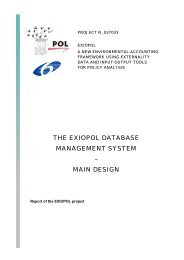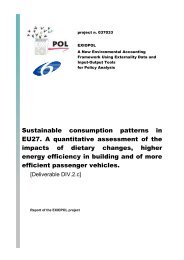Gulf and European Energy Supply Security - Feem-project.net
Gulf and European Energy Supply Security - Feem-project.net
Gulf and European Energy Supply Security - Feem-project.net
You also want an ePaper? Increase the reach of your titles
YUMPU automatically turns print PDFs into web optimized ePapers that Google loves.
2. structural Causes of oil Price Instability<br />
Oil prices, like the prices of most commodities,<br />
are unstable because of well-understood structural<br />
causes.<br />
Firstly, upfront investment is the key cost<br />
component, while direct costs are relatively less<br />
important. This means that once the investment<br />
is made <strong>and</strong> the capacity created, it will be utilized<br />
even if prices fall well below the break-even point.<br />
It is only if prices fall below direct costs that the<br />
producer will consider shutting capacity, <strong>and</strong> even<br />
then it may be costly (in terms of immediate costs or<br />
forfeited long term revenue) to shut in capacity.<br />
Secondly, investment<br />
gestation times are very long.<br />
For a while, the industry boasted<br />
that it was able to go from<br />
discovery to early production<br />
in a much shorter time than in<br />
the past, but a few exceptional<br />
examples in the offshore of the<br />
<strong>Gulf</strong> of Guinea have since been<br />
overshadowed by numerous<br />
disaster stories – from the <strong>Gulf</strong><br />
of Mexico to Sakhalin passing<br />
through Kashagan. Whether it<br />
is field development, pipeline<br />
construction, or refinery<br />
construction, this is an industry<br />
in which five to 10 years easily<br />
pass from the moment the investment is sanctioned<br />
to the moment it becomes operational. For all<br />
practical purposes, this means that investment is<br />
made with little or no knowledge of the returns it<br />
will bring when it becomes operational. True, the<br />
futures market can mitigate this risk <strong>and</strong> offers<br />
contracts <strong>and</strong> derivatives several years into the<br />
future, but liquidity at such distant maturities is thin<br />
<strong>and</strong> the feasibility of massive hedging of investment<br />
is problematic. In fact, very few major <strong>project</strong>s<br />
are financed with risk mitigation from the futures<br />
market.<br />
Thirdly, <strong>and</strong> most importantly, both dem<strong>and</strong><br />
<strong>and</strong> supply are rigid in the short term. Exhibit 1<br />
reproduces a slide used by Christopher Allsopp<br />
<strong>and</strong> Bassam Fattouh in a presentation given to<br />
Functioning of the International Oil Markets <strong>and</strong> <strong>Security</strong> Implications<br />
Exhibit 1: Oil Dem<strong>and</strong> Price Elasticity<br />
the Bank of Engl<strong>and</strong> in June 2008. 2 It summarizes<br />
different measures of price elasticity of oil dem<strong>and</strong><br />
estimated by various authors at different times.<br />
Short-term price elasticity has consistently been<br />
found to be very low, in fact very close to zero. Longterm<br />
elasticity is more significant, being estimated<br />
in a range of .5-.6 for the OECD countries <strong>and</strong><br />
much lower for the developing countries. Finally,<br />
authors that have repeated the estimation over<br />
time have found that price elasticity is declining<br />
– a consequence of the fact that oil has been<br />
largely substituted by other fuels in uses in which<br />
substitution was easy.<br />
Source: Christopher Allsopp <strong>and</strong> Bassam Fattouh, “Oil Prices: Fundamentals<br />
or Speculation?” (presentation at the Bank of Engl<strong>and</strong>, June 13, 2008)<br />
Exhibit 2 shows that the income elasticity of oil<br />
dem<strong>and</strong> is higher than the price elasticity, meaning<br />
that oil dem<strong>and</strong> can effectively be curbed only by<br />
reducing disposable income, i.e. through a recession.<br />
The very high income elasticity of dem<strong>and</strong> in the<br />
developing countries means dem<strong>and</strong> for oil tends to<br />
grow more rapidly than GDP in those countries.<br />
Finally, Exhibit 2 indicates that price elasticity<br />
of non-OPEC oil supply is also low – a reflection<br />
of the points mentioned above about investment<br />
being the main cost component <strong>and</strong> requiring long<br />
gestation. Of course, OPEC supply is considered a<br />
political variable, <strong>and</strong> it is exp<strong>and</strong>ed or contracted<br />
depending on the organization’s price target <strong>and</strong><br />
perception of market conditions – no structural<br />
elasticity can be measured.<br />
Source: Christopher Allsopp <strong>and</strong> Bassam Fattouh, “Oil Prices: Fundamentals<br />
or Speculation?” (presentation at the Bank of Engl<strong>and</strong>, June 13, 2008)<br />
1
















